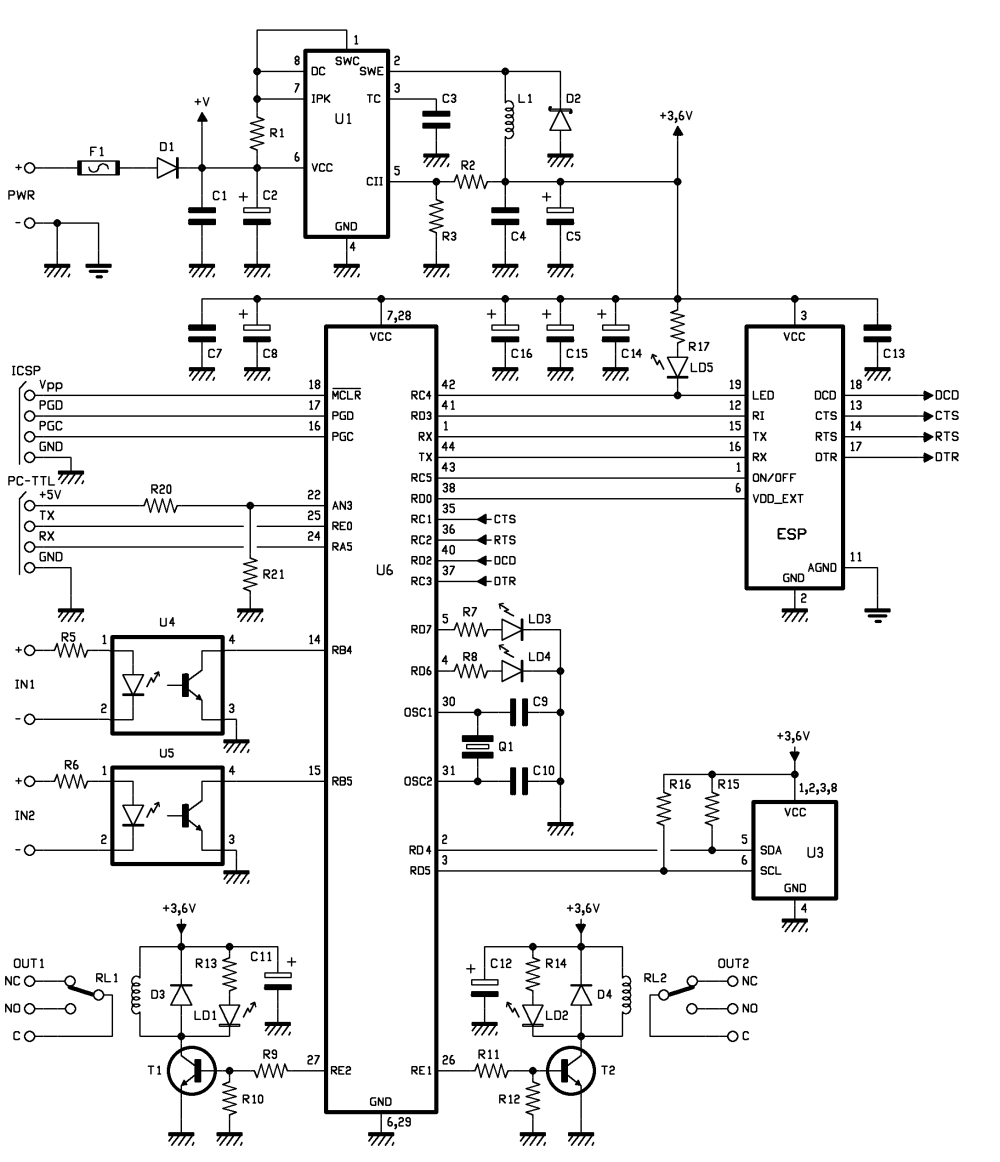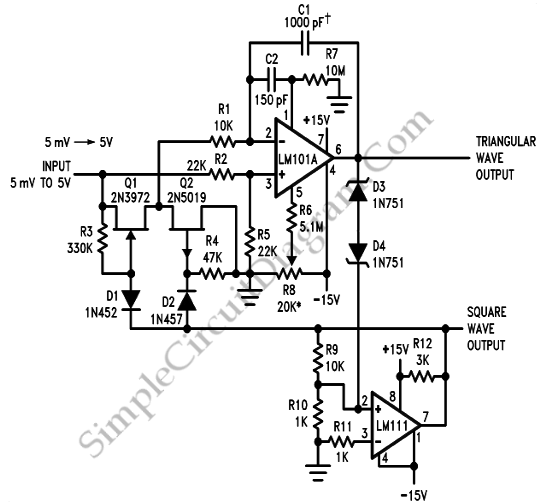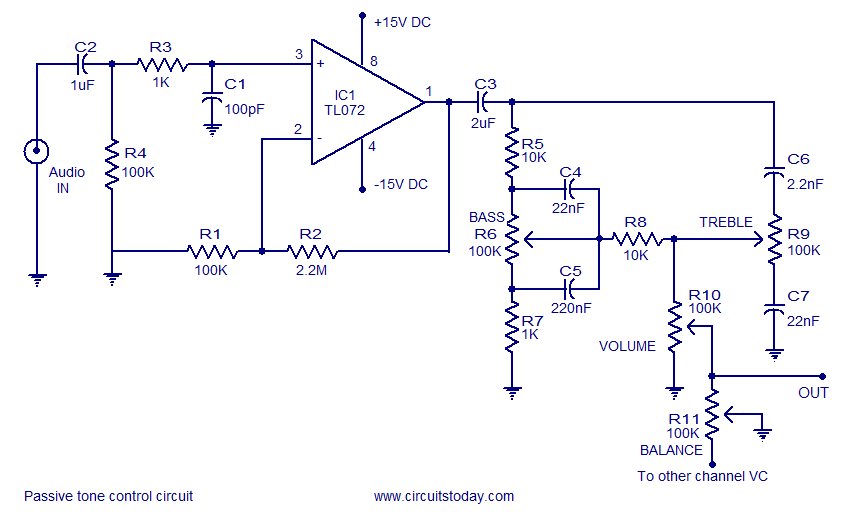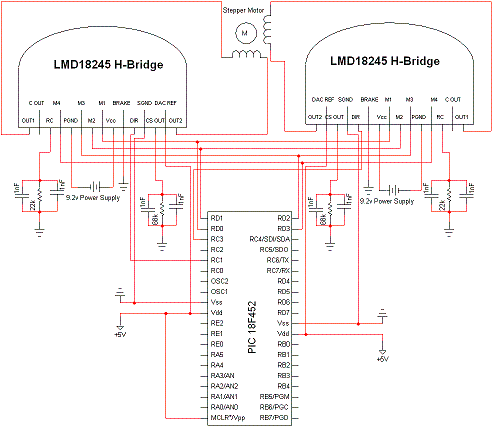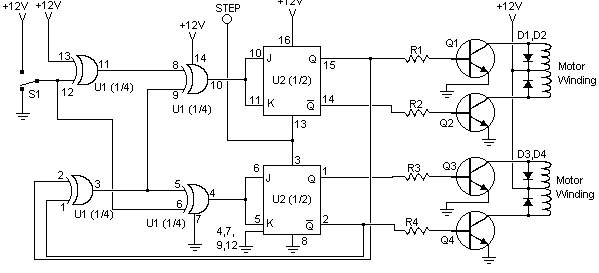
12-24V Impulse control dimmer
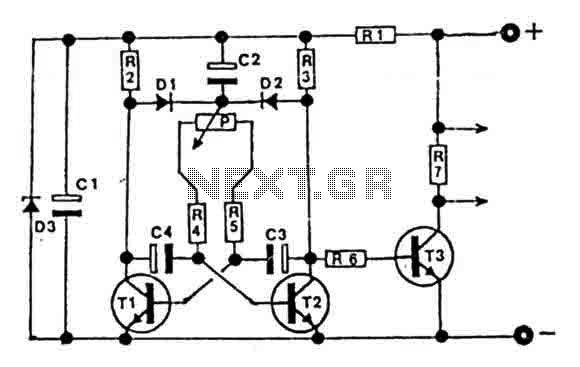
This circuit is designed for controlling motors, lamps, heating elements, and similar devices continuously from nearly zero to maximum capacity (5-95%). It utilizes impulse control for nearly lossless operation, providing almost total torque for motors. The transistor T3 must be securely mounted on a heatsink with minimum dimensions of approximately 100x100x5 mm. The heatsink must be insulated, as there is a conductive connection between the collector (C) terminal and the metal back side of the transistor. Additionally, the transistor T3 is at risk of destruction due to short circuits or overheating if the circuit is operated without a heatsink.
Parts:
- R1 = 330Ω 2W
- R2, R3 = 2.7kΩ
- R4 = 470Ω
- R5, R6, R7 = 1.5kΩ
- P = 2 x 100kΩ
- C1 = 47µF/10V
- C2 = 10µF/10V
- C3, C4 = 0.22µF/24V Tantalum
- D1, D2 = 1N4148
- D3 = Zener 10V 1W
- T1, T2 = BC237C
- T3 = BD331
The circuit operates by modulating the power supplied to the load, allowing for precise control over the output. The use of a transistor (T3) as the primary switching element enables efficient control of high currents while maintaining low power loss. The impulse control mechanism ensures that the load receives power in short bursts, which minimizes heat generation and improves efficiency.
The resistors (R1, R2, R3, R4, R5, R6, R7) serve various functions, including setting biasing levels for the transistors and controlling the current flow throughout the circuit. The potentiometer (P) allows for adjustable control of the output, enabling fine-tuning of the load's performance.
Capacitors (C1, C2, C3, C4) are included for filtering and stability, ensuring that the circuit operates smoothly without oscillations or spikes in voltage. The Zener diode (D3) provides voltage regulation, protecting the circuit from voltage surges that could damage sensitive components.
Diodes (D1, D2) are used for signal rectification and protection, ensuring that the transistors are not exposed to reverse voltage that could lead to failure. The transistors (T1, T2) are used for signal amplification and switching, while T3 handles the main power switching, requiring careful thermal management to prevent overheating.
Overall, this circuit design is robust and efficient for controlling various types of loads, provided that adequate thermal management is implemented for the transistor T3. Proper assembly and insulation of components are critical for reliable operation.This circuit is intended for use with motors, lamps,heatings etc. Continuously from nearly zero up to maximum capacity (5-95%). Almost lossfree control by means of this impulse control. Nearly total turning moment of motors. The transistior T3 must absolutely be fastened on a heatsink with minimum dimentions of approximate 100x100x5mm. The heatsink has to be fixed insulated as the transistor has a conductive connection between the C-connection and the metal rear side.
The transistor T3 can be destroyed by short circuit or by overheating if the circuit is operated without heatsink. --------------- Parts: R1=330-2W R2,R3=2,7K R6,R7,R5=1,5K R4=470 P=2X100K C1=47UF/10V C2=10UF/10V C3,C4=0.22UF/24v TANTAL.
D1,D2=1N4148 D3=ZENER 10V-1W T1,T2=BC237C T3= BD331
Parts:
- R1 = 330Ω 2W
- R2, R3 = 2.7kΩ
- R4 = 470Ω
- R5, R6, R7 = 1.5kΩ
- P = 2 x 100kΩ
- C1 = 47µF/10V
- C2 = 10µF/10V
- C3, C4 = 0.22µF/24V Tantalum
- D1, D2 = 1N4148
- D3 = Zener 10V 1W
- T1, T2 = BC237C
- T3 = BD331
The circuit operates by modulating the power supplied to the load, allowing for precise control over the output. The use of a transistor (T3) as the primary switching element enables efficient control of high currents while maintaining low power loss. The impulse control mechanism ensures that the load receives power in short bursts, which minimizes heat generation and improves efficiency.
The resistors (R1, R2, R3, R4, R5, R6, R7) serve various functions, including setting biasing levels for the transistors and controlling the current flow throughout the circuit. The potentiometer (P) allows for adjustable control of the output, enabling fine-tuning of the load's performance.
Capacitors (C1, C2, C3, C4) are included for filtering and stability, ensuring that the circuit operates smoothly without oscillations or spikes in voltage. The Zener diode (D3) provides voltage regulation, protecting the circuit from voltage surges that could damage sensitive components.
Diodes (D1, D2) are used for signal rectification and protection, ensuring that the transistors are not exposed to reverse voltage that could lead to failure. The transistors (T1, T2) are used for signal amplification and switching, while T3 handles the main power switching, requiring careful thermal management to prevent overheating.
Overall, this circuit design is robust and efficient for controlling various types of loads, provided that adequate thermal management is implemented for the transistor T3. Proper assembly and insulation of components are critical for reliable operation.This circuit is intended for use with motors, lamps,heatings etc. Continuously from nearly zero up to maximum capacity (5-95%). Almost lossfree control by means of this impulse control. Nearly total turning moment of motors. The transistior T3 must absolutely be fastened on a heatsink with minimum dimentions of approximate 100x100x5mm. The heatsink has to be fixed insulated as the transistor has a conductive connection between the C-connection and the metal rear side.
The transistor T3 can be destroyed by short circuit or by overheating if the circuit is operated without heatsink. --------------- Parts: R1=330-2W R2,R3=2,7K R6,R7,R5=1,5K R4=470 P=2X100K C1=47UF/10V C2=10UF/10V C3,C4=0.22UF/24v TANTAL.
D1,D2=1N4148 D3=ZENER 10V-1W T1,T2=BC237C T3= BD331
